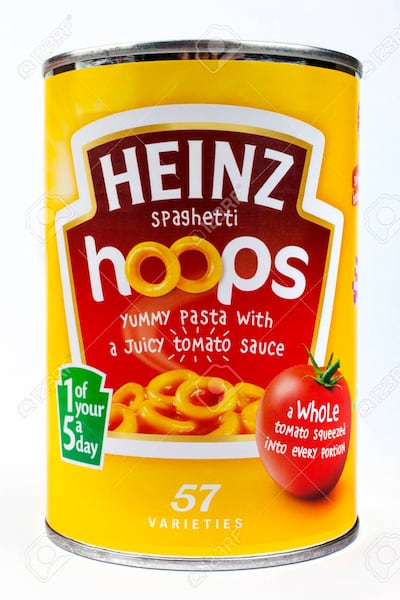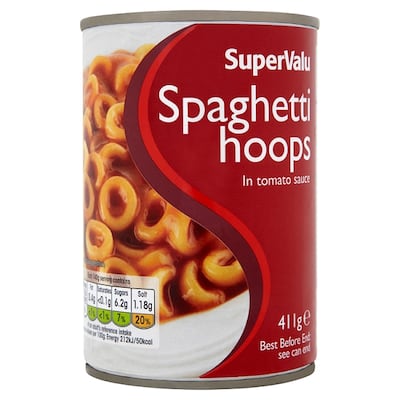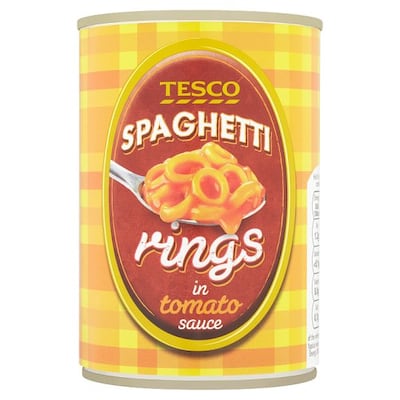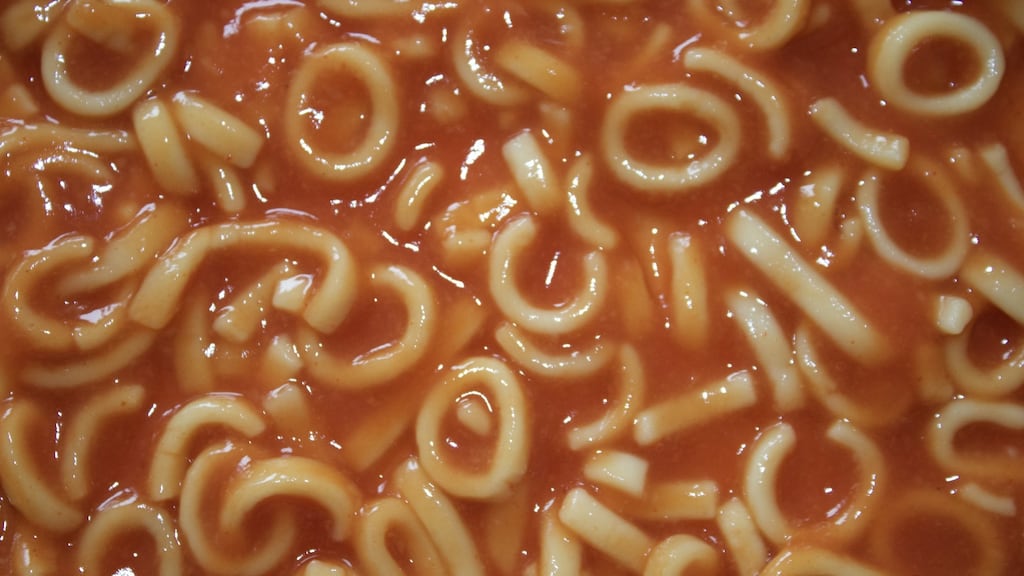It might seem difficult to get excited about spaghetti hoops, but I always associate them with power cuts, candles and ghost stories by the fire on rare winter evenings. Storms that took down power lines on occasion when I was a child made cooking difficult, so the emergency tinned goods were fished out from the back of the cupboard.
The excitement of being allowed to eat pasta hoops in tomato sauce as a child has never left me, even though I remember well the bland taste and squishy consistency. The only pasta we ate then was in a tin and from Heinz.

That brand is now one of the most expensive on sale. Its 400g tin of hoops costs about €1, which is more than twice the price of those at the discount retailers. It does, however, highlight that there is “a whole tomato squeezed into every portion”. So that means there are two in this tin, as one portion is half a tin. It’s impossible to know what size they are, but at least they are using full tomatoes rather than a powder or a paste.
It also says there is "One of your five a day" in the can. The "five a day" refers to the idea that we are advised to eat at least five portions of fruit or vegetables each day for the good of our health. The British NHS, on its Eat Well web page, explains that 80g of fresh, canned or frozen fruit or vegetables counts as a portion, which sounds about right for the weight of two tomatoes.
The ingredient list reads: spaghetti hoops (42 per cent, water, durum wheat semolina), tomatoes (41 per cent), water, sugar, modified cornflour, salt, citric acid, spice, garlic salt, herb extract and spice extract. Semolina is a type of grainy flour, which in this case is made from coarse durum wheat, which has a high protein content, including gluten. It was used to make the hoops. There is sugar – but then it’s hard to find a processed product that doesn’t have sugar now. Citric acid is a flavour enhancer and can give a slightly tart taste. The rest of the ingredients are fairly standard for a processed food.
Egg on your face
It also says “May contain egg”, which really highlights that anyone with an allergy to egg needs to check the labelling on foods regularly, as this is not an ingredient but may come from cross-contamination.
Supervalu’s hoops are cheaper at about 60 cent and come in a bigger 411g tin, but are not very different. The list runs: tomato puree (41 per cent), cooked spaghetti (37 per cent) (water, spaghetti (durum wheat semolina)), water, sugar, salt, modified maize starch, flavouring, spices and citric acid as an acidity regulator. So it’s a puree rather than real tomatoes.

This tin uses the traffic light symbols on the front, indicating that the product gets the green light on calories, sugars and fat, but an orange light for salt.
What’s odd about the Supervalu tin is that it seems the manufacturers want you to get three servings out of it. It has a serving down as 140g per person, which is a lot less than 200g in the half tin Heinz expects you to eat. This means that Supervalu says on the front of the can that one portion has just 70 calories, while the Heinz can says there is 106 calories. In fact, they both have almost exactly the same number of calories.
This is further proof that you really should not be fooled by what you read on the front of a packet when it comes to serving size.
A few surprises
Tesco Spaghetti Rings in tomato sauce are much cheaper at 42 cent, but have a few surprises in store. The 410g Every Day Value brand contains cooked pasta (42 per cent) (water, durum wheat semolina), tomato puree (38 per cent), water, sugar, glucose-fructose syrup, modified maize starch, salt, ground paprika, potato starch, acidity regulator (citric acid), onion powder and flavouring.
If you think the sauce tastes good, you can thank the glucose-fructose syrup and the “flavouring”. Glucose-fructose syrup is similar to the high-fructose corn syrup blamed for some of the obesity problems in the US. It is more commonly seen in sugary drinks and is best avoided.

A better prospect is Lidl Spaghetti Loops, which come in a 410g tin for about 40 cent. They have: 41 per cent spaghetti loops (durum wheat semolina, water), 33 per cent tomato puree, water, sugar, modified maize starch, salt, ground paprika, potato starch, citric acid, onion powder and flavourings. For the price conscious, these are not a bad choice.
FOOD LABELS SERIES
1) Being a successful shopper
2) Bread
3) Milk
4) Cereal
5) Rashers
6) Yoghurt
7) Soup
8) Hummus
9) Pasta sauce
10) Chinese ready meals
11) Frozen chips
12) Chilled fish
13) Egg
14) Chicken Kiev
15) Crisps
16) Mayonnaise
17) Baked beans
18) Tomato ketchup
19) Chocolate digestive biscuits
20) Avocados
21) Cadbury's Dairy Milk
22) Dark chocolate
23) Salad Cream
24) Pesto sauce
25) Smoothies
26) Sliced ham
27) Vanilla ice cream
28) Ice-pop
29) Jaffa cakes
30) Protein bars
31) Energy bars
32) Chicken Tikka Masala
33) MiWadi
34) Peanut butter
35) Spaghetti hoops


















